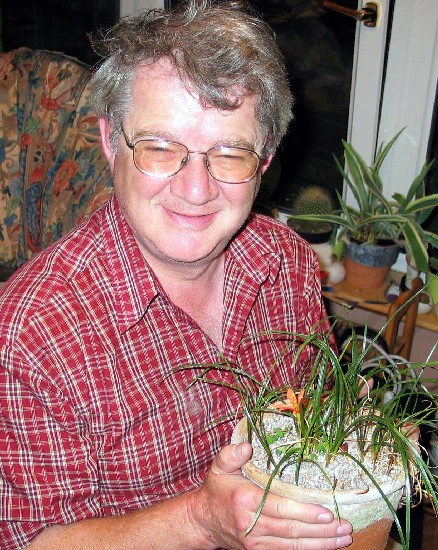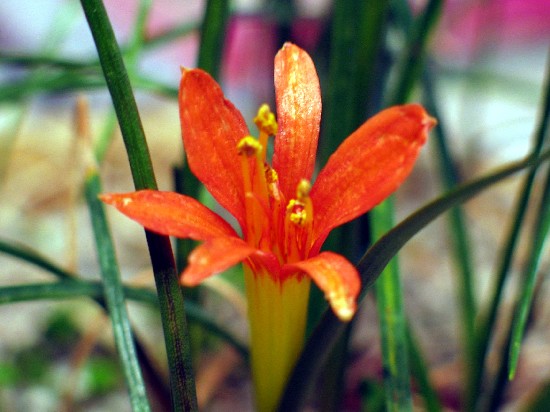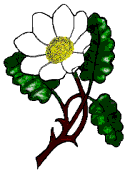|
September 2004
Crocopsis fulgens
by Sandy Leven
Little has been written about this Peruvian scarlet 'crocus'. Fred Hunt wrote a plant portrait in January 1989 edition of our journal The Rock Garden and accompanied this with a nice picture. Since then zilch! When my plants decided to flower this year after a period of inactivity I thought I'd better take a picture. Unfortunately although I had three flowers, they came one at a time. You have to be quick. Each flower lasts a few days at the most and or an even shorter time in scorching hot sunshine. A working person could easily miss the event.

I then decided to find out more about Crocopsis fulgens, which Fred and the AGS Dictionary describe as the member of a mono-typic genus. It is a member of the Amaryllidaceae and so has six petals. It looks just like bright red crocus with a long yellow tube. The flowers are sessile. They look like a crocus or a colchicum, but are related to neither. Crocus are in the Iridaceae and Colchicum are in the Liliaceae. Recently taxonomists have looked at Crocopsis fulgens and while it is still an Amaryllid it is suggested that it might be relocated and called Stenomesson humile, Stenosmesson acaule, Clitanthes humilis or Zephyranthes pseudocolchicum. What a choice of names! On the internet there is little information under any of the names. There are two picture of other Stenomesson species on Paul Christian's website and they both look like Small Hippeastrums or Rhodophthalias. - viz. tubular flowers on a relatively long stem, not in the least sessile. I will continue to call it Crocopsis fulgens a name which at
least is pronounceable and a bit exotic. Like Fred I was given bulbs by Harold Esselmont in the mid-eighties. I fed my pot of bulbs and did not disturb them till they were nearly pot bound. Fred re-potted his regularly. When I re-potted them I had a huge number of bulbs. I was able to fill 3 or 4 pots and to put some into the auction at successive Discussion weekends. Some went to Dublin! I thought that iff they were pot-bound they might decide to flower. I now think hey should be left alone to fill their pot and that they will flower sparsely in the second year after re-potting.
The bulbs increase by stolons, which when they are growing well are freely produced, so it doesn't take long to grow a potful of the dark green, shiny strap-like leaves. Flowers are another matter! I don't feed them as much as I might but I did give them some Sulphate of potash, as Ian Young advises, so this might have spurred them on this summer. I have tried keeping the pots in various positions, from full sun to shade under the staging. I keep hem frost free. Those which were not kept frost free died.

The foliage dies back to an extent during winter but can be present at anytime. Supposing they have died back, they emerge in late spring. From then on I give the full sun under glass. They are almost cooked and don't mind. I water them regularly but the pots are never wet. All summer they are surrounded by pots of other dormant bulbs. They relish hot dry conditions. Fred says that Harold told him our bulbs were collected b y Munn in the Peruvian Andes, near Sacsayhuaman in 1976. I thought, 'That must be a hot dry place!' I looked Sacsayhuaman up on the internet and it does look dry. It is near Cusco, which is famous for its Aztec ruins, huge blocks of black stone perfectly fitted together. The surrounding country looks brown and dry. Perhaps it is in a rain shadow. I even tried to find out about 'Munn'. The most famous Munn associated with Peru is Charles A Munn who is a world expert in macaws but whose writings seem to start in the 80's. I doubt there can be two people called Muun associated with the natur
al history of Peru, unless they be brothers or father and son. I have asked the US State department for information about Charles A. Munn and I await their answer.
Its combination of scarlet and yellow flower combined with the history of its homeland ensures that it is not an ordinary plant, whatever it is called. I m delighted when it flowers. Out of lower it reminds me of Harold Esselmont, the gentleman of rock gardening. Since it seems to be so rare, perhaps I should increase he numbers of my bulbs and go into commercial production. Hopefully another expedition will come across it and it will be re-introduced. Mine never set seed, probably because all my bulbs are one clone, though remember that Harold new the collection number [Munn166].
Whatever its name, whenever it flowers it is a delight and I for one would prefer it to remain mono-typic.
^ back to the top ^
|

